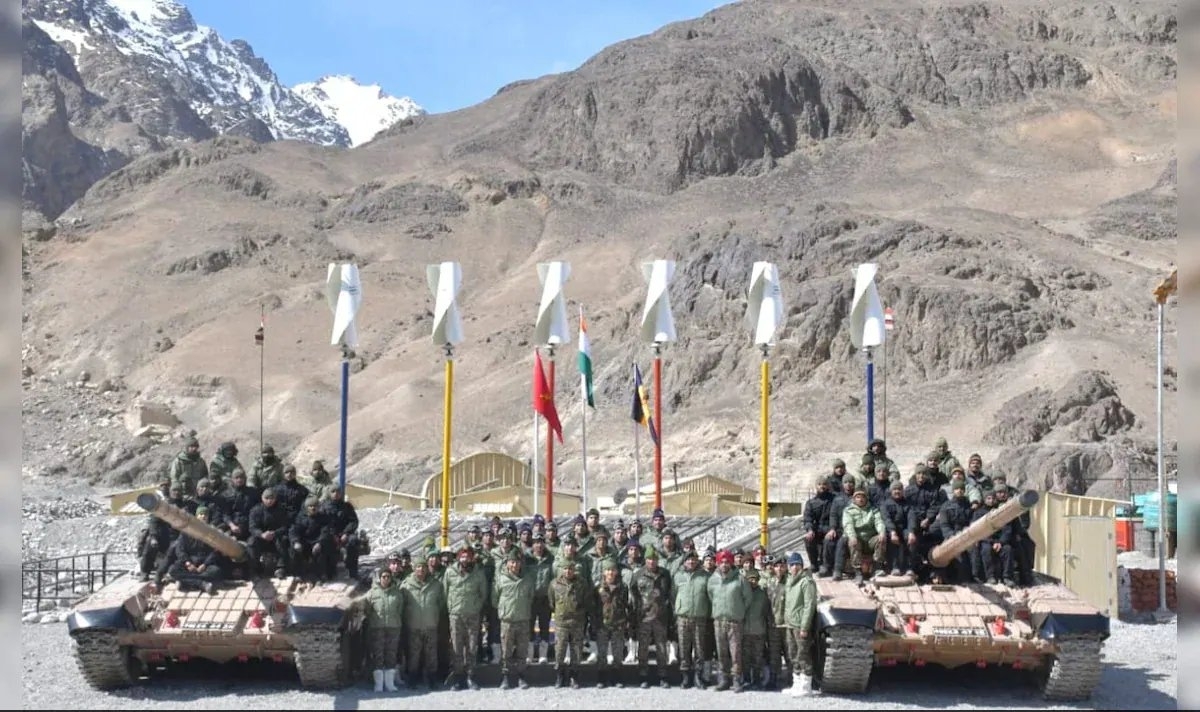Indian Army Imagine a battlefield where the air is thin enough to make breathing a challenge, temperatures plummet to bone-chilling lows, and the unforgiving landscape seems to rise endlessly towards the heavens. This isn’t the setting for a science fiction film; this is the reality for the Indian Army guarding the Line of Actual Control (LAC) with China, a region perched precariously over 14,500 feet above sea level. Here, amidst the breathtaking scenery and harsh conditions, lies a testament to Indian Army ingenuity and resolve – the world’s highest tank repair facilities.
These facilities are more than just workshops; they are a symbol of India’s commitment to defending its borders and a testament to the dedication and innovation of its military. This blog delves into the story behind these remarkable facilities, exploring their significance, the challenges overcome in their creation, and the impact they have on India’s strategic posture.
he Strategic Significance: A Battlefield High Above the Clouds
The LAC with China is a sensitive border region, demanding a constant state of preparedness. Maintaining a well-oiled and operational armored force becomes paramount for deterring potential threats and ensuring a swift response in case of conflict. However, the extreme altitude of the region presented a logistical nightmare. Traditionally, transporting tanks and armored vehicles down from the mountains for repairs was not only time-consuming but also exposed them to additional wear and tear. Furthermore, maintaining a readily available pool of spare parts and skilled technicians at such high altitudes was a significant challenge.
A Legacy of Challenges: Indian Army
The Indian Army has a long history of operating in high-altitude regions like the Himalayas. However, logistical constraints have always posed a challenge in maintaining military equipment at such extreme elevations. Here’s a closer look at some of the historical hurdles:
Thin Air, Big Problems: The thin air at high altitudes affects the performance of internal combustion engines, making it difficult for tanks and other armored vehicles to function optimally. Regular maintenance becomes even more crucial to ensure their continued effectiveness.

The Tyranny of Terrain:
The rugged mountain terrain poses significant challenges for transporting heavy equipment and spare parts. The sheer difficulty of traversing treacherous mountain passes creates delays and logistical bottlenecks.
Weather Warriors:
The harsh weather conditions, characterized by extreme cold, blizzards, and unpredictable snowfall, can damage exposed equipment and hinder repair efforts.
These factors combined meant that maintaining a fully operational armored force on the LAC was a constant struggle.
Building on the Roof of the World: Overcoming the Odds
The Indian Army, recognizing the strategic importance of a robust armored force at high altitudes, embarked on a groundbreaking project to establish the world’s highest tank repair facilities. This ambitious undertaking demanded meticulous planning and the ingenuity of engineers, logistics teams, and construction specialists.
Planning and Preparation:
The project began with a thorough planning phase involving engineers, logisticians, and military strategists. Every aspect, from the physical layout of the facilities to the types of equipment needed, was meticulously considered.
Taming the Terrain:
Constructing facilities in such a challenging environment demanded innovative solutions. Specialized machinery and advanced construction techniques were employed to ensure the structures could withstand the harsh weather and shifting mountain terrain.

Technological Innovation:
Pre-fabricated structures that could be easily transported and assembled on-site were a key innovation. Additionally, the use of lightweight, high-strength materials helped to minimize the weight of the facilities without compromising their durability.
The construction process itself was an arduous task. Workers braved extreme weather conditions and the constant threat of altitude sickness to complete the project.
Unveiling the Marvel: A Closer Look at the Facilities
The completed facilities are marvels of engineering, specifically designed to meet the unique challenges of high-altitude operations.
Designed for Diverse Needs:
The facilities cater to a wide range of tanks and armored vehicles deployed in the region, ensuring that the Indian Army’s entire armored fleet can be maintained efficiently.
A Comprehensive Repair Arsenal:
These workshops are equipped with state-of-the-art diagnostic tools and repair machinery, allowing for a comprehensive range of maintenance services, from routine checkups to major repairs.
Technology at the Helm:
Advanced computer systems and specialized software are utilized to diagnose problems quickly and efficiently, minimizing downtime for vehicles.
Spare Parts Secured: Dedicated storage facilities ensure a readily available supply of essential spare parts, crucial for on-site repairs and preventing delays.
Skilled Workforce:
Technicians specially trained for high-altitude operations work within the facilities. These skilled professionals ensure a quick turnaround time for repairs and maximize the operational efficiency of the armored vehicles.

The Impact: A Game-Changer for Defense and Development
The establishment of these world-class facilities has a significant impact not only on



